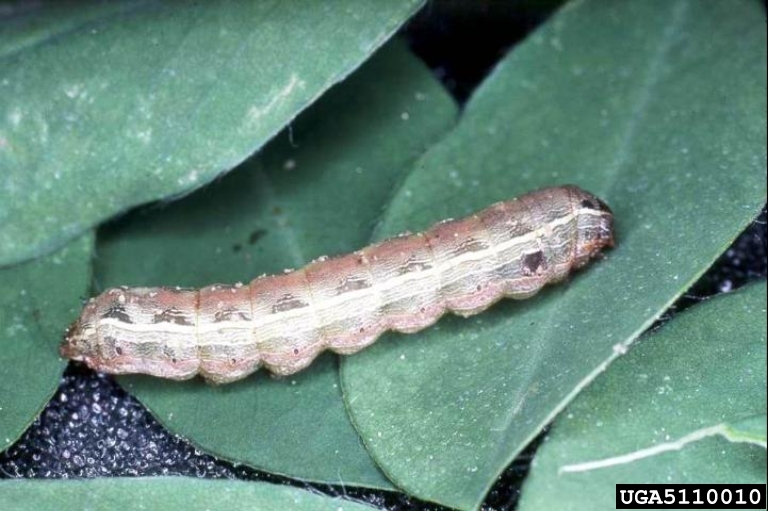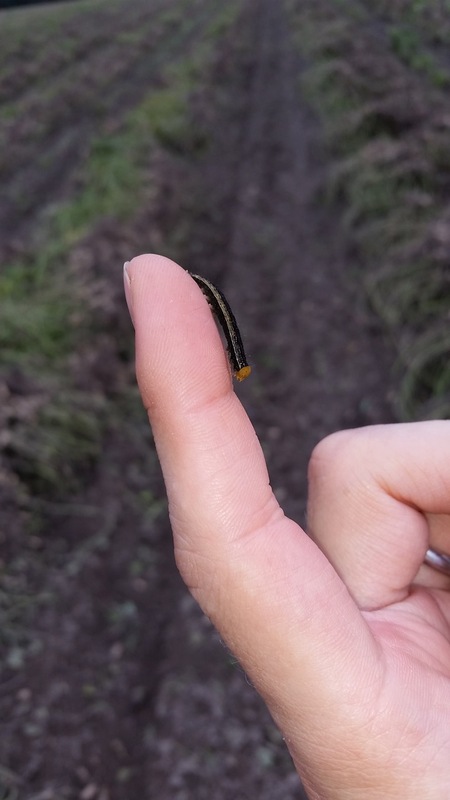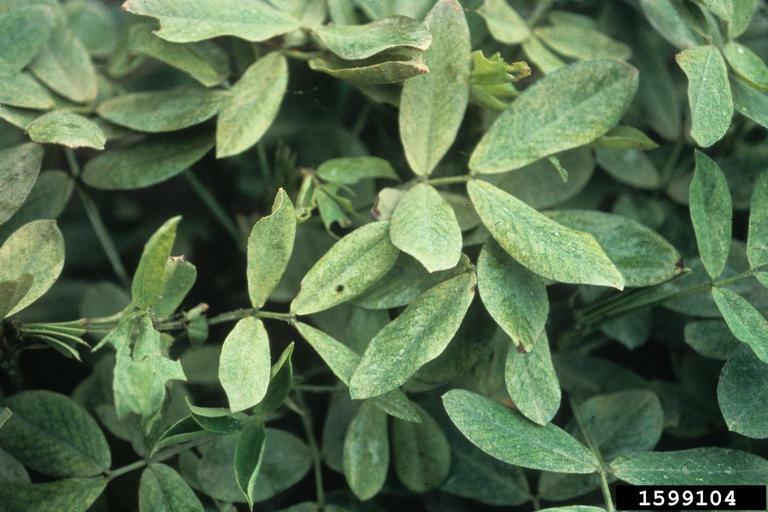Scientific Clarification
The following are the crop details for Groundnuts
- Scientific name: Arachis hypogaea
- Local names: Njugu (Swahili)
- Order: Fabales
- Family: Fabaceae
- Genus: Arachis

Harvesting peanut

Peanut kernels

Peanut with flower

Peanut flower and bee

Harvesting peanut

Peanut field

Peanut seedlings

Peanut foliage

Peanut foliage
General Information
Groundnuts are small erect or trailing herbaceous legumes, about 15 to 60 cm high. The fruit is a pod with one to five seeds that develop underground within a needle-like structure called a peg.
The leaves are arranged in alternate pairs and have leaf-like attachments near the stalk. The groundnut plant produces yellow, orange, cream, or white flowers which produce 'pegs', characteristic floral structures which sink into the ground to grow the pod. The pods can reach up to 10 cm (4 in) in length and can contain between 1 and 5 seeds. The plant can reach 0.6 m (2 ft) in height depending on the variety and as an annual plant, survives only one growing season.
The seeds are rich in oil (38-50%), protein, calcium, potassium, phosphorus, magnesium, and vitamins.
Groundnuts also have considerable medicinal value. They are reported to be useful in the treatment of diseases such as hemophilia, stomatitis, and diarrhea.
In sub-Saharan Africa, groundnuts are a basic staple crop, cultivated mainly by small-scale farmers both as subsistence and as a cash crop. It is an important source of protein and other nutrients for poor rural communities. In Africa, groundnut yields are traditionally low, due to unreliable rains, little technology available to small-scale farmers, pest and disease occurrence, poor seed variety, and increased cultivation on marginal land (ICRISAT).
Groundnuts may also be referred to as peanut, monkeynut, or earth nut. Groundnuts originated in South America from southern Bolivia to north-western Argentina. The Portuguese took them from Brazil to West Africa and then to southwestern India in the 16th century. Africa is now regarded as a secondary center of diversity.

Peanut Processing

Roasted, salted peanuts
Groundnut Varieties in Kenya
There are two main varieties of groundnuts in Kenya:
The runner is a large variety and it's highly preferred because of high yields, it matures in 90-100 days. Bunch varieties are small, tastier, and highly marketable, it matures in 60- 75 days.
Other varieties include Red Valencia, Red Oriata, Manipinta, Makulu Red, Bukene, Homa Bay, Texas Peanut, and Atika.
Red Valencia: This variety is easy to grow and produces two to five kernels per long pod. It’s slightly smaller in size and has a sweeter taste with papery red seed covers.
Climate Conditions, Soil, and Water Management
Groundnuts are grown in most tropical, subtropical, and temperate countries between 40°N and 40°S latitude, especially in Africa, Asia, North, and South America. They are grown in the warm tropics and subtropics below 1500 m above sea level, and in temperate humid regions with sufficiently long warm summers. The optimum mean daily temperature to grow is 30°C and growth ceases at 15°C. Cool temperatures delay flowering. Groundnuts cannot stand frost. Between 500 and 600 mm of water reasonably well distributed through the growing season allows good production.
Groundnuts are drought-tolerant species and can withstand severe lack of water, but the yield is generally reduced. If harvesting conditions are wet, aflatoxins (severe poison produced by some fungi such as Aspergillus spp) may develop on the nuts. Aflatoxin contamination is a major hazard to human and animal health. When groundnuts are poorly dried and stored, they pick mold and dirt, which attracts fungi, that release aflatoxin chemicals that are dangerous to human health, especially the liver.
Pods develop underground and must be recovered at harvest, therefore crumbly, well-drained soils are preferred, but plants grow and develop adequately on heavier clay soils. For optimum growth, soil pH should be in the range of 5.5 to 6.5, though Bunch types tolerate more acidic conditions (pH 4.5) and some cultivars grow well in alkaline soils up to pH 8.5.
Uses
Most commercially grown peanuts are used for the extraction of their oil which is used in cooking. The by-product of oil extraction is a pressed cake which is used as animal feed and also in the production of peanut flour. Raw kernels are also commonly roasted and eaten as a snack food.
The vegetative residues from the crop are excellent forage.
Planting Procedure
Peanut is usually propagated from seed. Seeds should be planted in a well-prepared seedbed in soil that is loose and crumbly with no large clumps. The seedbed should be free from weeds which will compete with the peanut seedlings. Weeds may be removed by hand cultivating or through the use of an appropriate herbicide. Peanut seeds should be planted by hand to a depth of 3–5 cm (1–2 in). It is best to ridge the soil or use flat beds as this will make harvesting the peanuts easier.
After ploughing and harrowing to a fairly good tilth, ridges that are 80 cm apart with flattish tops, should be made so that two rows of nuts can be planted on each ridge. Seeds for planting should be well selected: they should be clean, well-filled, and without any blemishes. Seeds should be kept in their pods and shelled a few days before planting. Planting depth is like maize about 5 to 8 cm. Seed rate is 40 to 50 kg/ha depending on the size of the seeds.
Intercropping
They can be grown as a sole crop and also intercropped with maize, soybean, and cassava. It is also a good intercrop for upland rice, sorghum, okra, sugarcane, and sunflower.
In some areas, they are grown under perennial tree crops such as coconut, oil palm, or rubber. Groundnuts when used as intercrop for upland maize and planted along the contour reduce soil runoff. The plant also reduces the population of African bollworms because it serves as a hiding place for beneficial insects. There is an increase in the yield of groundnuts when intercropped with early-maturing pigeon peas.
Husbandry
To achieve maximum economic yields, weeds must be eliminated. Groundnuts are poor competitors with weeds during the early stages of growth. Weeding should be done early while at the same time earthing up the ridges to encourage "pegging" i.e. young nuts penetration through the soil. Once pegging has started, only hand weeding should be undertaken to avoid disturbing the young nuts or damaging the flowers. Clean weeding should be done in up to 6 weeks after which hand weeding should take over.
The only peculiar nutrient requirement is for calcium (Ca) in the podding zone. Calcium is absorbed directly by the pods if soil moisture is adequate. A shortage of Ca in that zone will result in empty pods (especially in Runner cultivars). The crop's needs for nitrogen should be satisfied with symbiotic fixation by strains of Rhizobium of the cowpea group, so nitrogen fertilizers are not generally required.
In some areas of acid soils, lime is applied to raise the pH and supply Ca. Moisture stress during flowering or pod filling reduces yield therefore irrigation is important during those periods to minimize or eliminate the stress, and increase production and seed quality. Where yields are unsatisfactory (heavily eroded soils) an application of 200 kg/ha of rock phosphate is recommended.
Harvesting
Bunch cultivars are harvested 85-100 days after sowing and Runner cultivars 110-130 days after sowing in the warm tropics. Dig a few plants up to see if the nuts are ready. The nuts should be brown on the outside, firm, and dry. Usually, at maturity the inside of the pods is grey and some rattling occurs when pods are shaken. Severe disease of foliage sometimes results in harvesting before seeds are fully mature.
Plants should be carefully dug out to avoid nuts breaking off and remaining in the ground. Dry for 2-3 days, then rip the pods from the bushes and place them on mats to dry for another 7-10 days to about 10% moisture.
Shelling should be done by hand. Broken, dirty, or damaged nuts should be discarded as these will lower the quality and hence the selling price. When the groundnuts are poorly dried and stored, they pick mold and dirt, which attracts fungi, that release aflatoxin chemicals that are dangerous to human health, especially the liver. Nuts to be used as seeds the following year should not be shelled.
References
CABI Crop Protection Compendium. (2010). Arachis hypogaea (groundnut) datasheet. Available at: http://www.cabi.org/cpc/datasheet/6932. [Accessed 06 March 15].
Paid subscription required.
Duke, J. A. (1983). Arachis hypogaea L. Handbook of Energy Crops. unpublished. Available at: http://www.hort.purdue.edu/newcrop/duke_energy/Arachis_hypogaea.html#Ecology. [Accessed 06 March 15].
Free to access.
Kokalis-Burelle, N., Porter, D.M, Rodríguez-Kábana, R., Smith, D. H. & Subrahmanyam, P. (Eds.) (1997). Compendium of peanut diseases. Available at: http://www.apsnet.org/apsstore/shopapspress/Pages/4218X.aspx.
Available for purchase from APS Press.
Wright, S. (2012). Peanuts. University of Kentucky College of Agriculture Cooperative Extension Service. Available at: http://www.uky.edu/Ag/NewCrops/introsheets/peanuts.pdf. [Accessed 06 March 15].
Free to access.
Common Pests and Diseases
Diseases
Category : Fungal
Botrytis blight
Botrytis cinerea
Symptoms
Numerous spots on upper surface of leaflets; entire plant or discrete parts may wilt and die; pods and stems become covered in fungal sclerotia.
Cause
Fungus
Comments
Management
Avoiding frost damage by planting early peanut varieties can help protect the plant from fungal colonization; application of appropriate foliar fungicides (e.g. benomyl), where available, can help to control the disease.
Charcoal rot
Macrophomina phaseolina
Symptoms
Water soaked lesions on stems of seedlings close to soil line; lesions girdle stem and kill seedlings; lesions in similar area may be present in older plants; lesions are initially water-soaked but turn brown; if lesions girdle the stem, plant wilts and branches die; infections beginning in the roots cause leaves to turn yellow and wilt and causes stems to be blighted.
Cause
Fugnus
Comments
Management
Rotating crop with rice for a period of 3-4 years can reduce the level of oioculum in the soil; providing the plants with adequate irrigation and fertilization reduces susceptibility to the disease; there are currently no resistant varieties of peanut; frequent irrigation to wet soil reduces the incidence of the disease.
Cylindrocladium black rot
Cylindrocladium crotalariae

Blackened and shriveled roots due to black rot infection
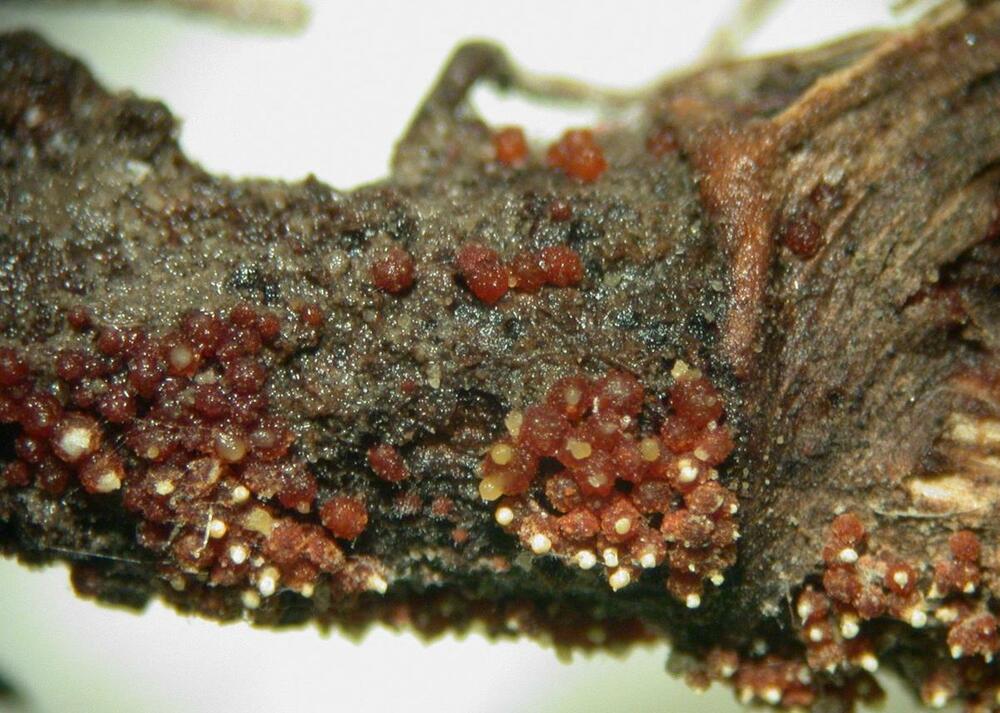
Clusters of fungal fruiting bodies on peanut stem

Rotting caused by Cylindrocladium black rot on peanut

Plants yellowing and wilting
Symptoms
Leaves on main stem turning chlorotic and wilting; entire plant wilts very rapidly when there is a period of water stress following high moisture; clusters of red-brown fungal bodies occur on on stems, pegs and pods; roots destroyed; roots blackened and shriveled.
Cause
Fungus
Comments
Management
The most effective method to control the disease is to plant peanut varieties that have some resistance to the disease; rotation of crop with nonhost such as corn , cotton or tobacco may help to reduce inoculum in the soil; application of appropriate soil fumigants in heavily infested fields can help to control the disease.
Early leaf spot
Cercospora arachidicola
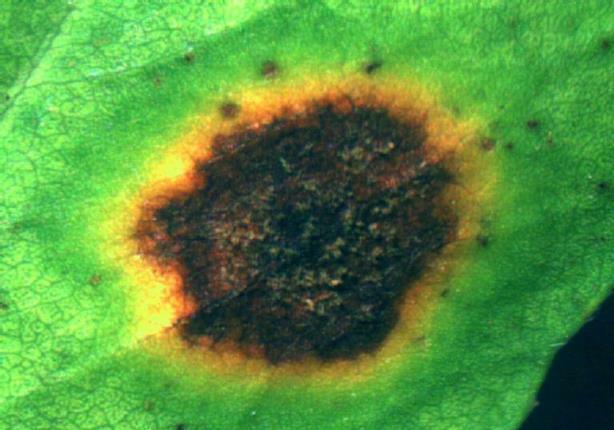
Close-up image of an early leaf spot lesion on peanut

Symptoms of early leaf spot on peanut leaves
Symptoms
Small chlorotic flecks on leaf petioles, stems and pegs which enlarge and turn dark in color; lesions on upper surface of leaves usually possess a yellow halo and are reddish brown on the underside of leaves.
Cause
Fungus
Comments
Management
If disease is present, a rotation away from peanut for a period of 2-3 years is advised but is insufficient to control the disease completely; peanut crop debris should be plowed into soil after harvest and any volunteers removed from the nonhost crop; fungicides should be applied with caution as they can exacerbate other foliar diseases where they are present.
Late leaf spot
Cercospora personatum

Severe defoliation in peanut field infected with Cercospora

Peanut plant infected with Cercospora fungus

Cercospora lesions on peanut

Cercospora infected peanut leaves

Peanut plant infected with Cercospora fungus

Defoliation due to Cercospora infection
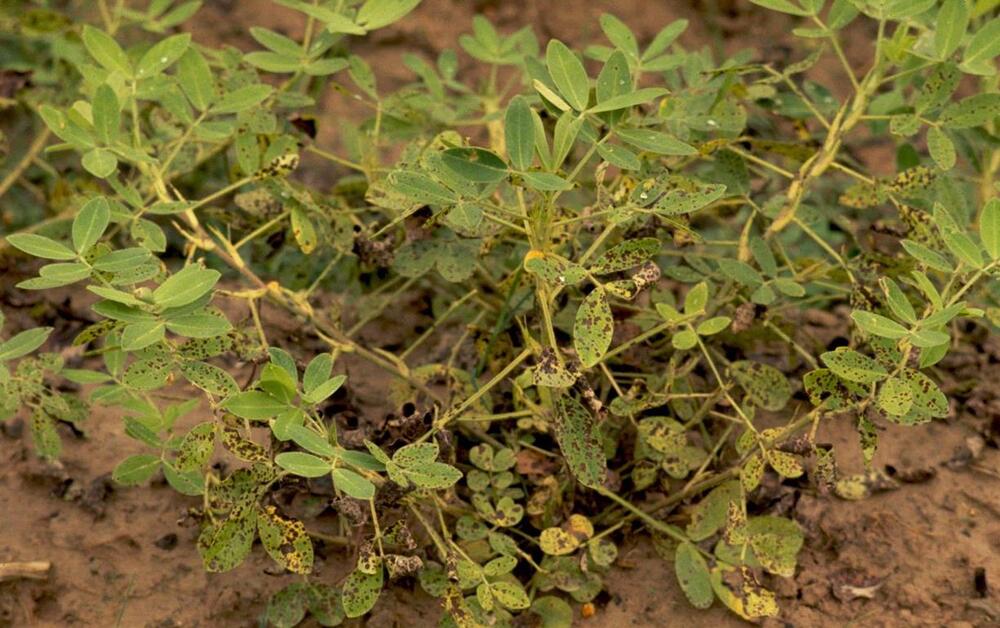
Peanut plant infected with Cercospora fungus
Symptoms
Small chlorotic flecks on leaf petioles, stems and pegs which enlarge and turn dark in color; symptoms may be very similar or identical to early leaf spot and can only be differentiated by examination of conidia under a microscope.
Cause
Fungus
Comments
Management
If disease is present, a rotation away from peanut for a period of 2-3 years is advised but is insufficient to control the disease completely; peanut crop depris should be plowed into soil after harvest and any volunteers removed from the nonhost crop; fungicides should be applied with caution as they can exacerbate other foliar diseases where they are present.
Phyllostica leaf spot
Phyllostica arachidis-hypogaea
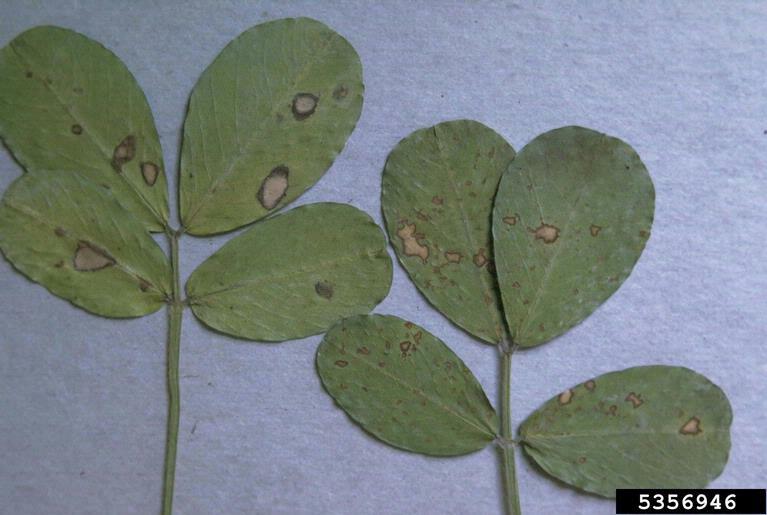
Circular lesions with red-brown margins and light brown or tan centers on leaves

Symptoms of Phyllostica leaf spot on peanut leaves
Symptoms
Circular lesions with red-brown margins and light brown or tan centers on leaves; centers of lesions may dry out and drop from leaf resulting in a "shot-hole" appearance.
Cause
Fungus
Comments
Management
Disease is held in check by fungicides applied to control early or late leaf spot.
Rust
Puccinia arachidis

Rust symptoms on peanut

Symptoms of rust on peanut leaves

Rust symptoms on peanut

Symptoms of rust on peanut leaves

Rust symptoms on peanut

Rust symptoms on peanut

Symptoms of rust on peanut leaves

Rust symptoms on peanut
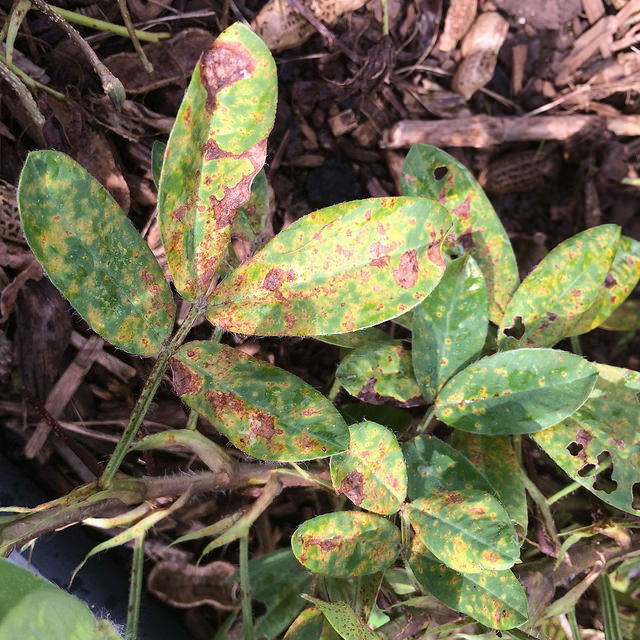
Symptoms of rust on peanut leaves
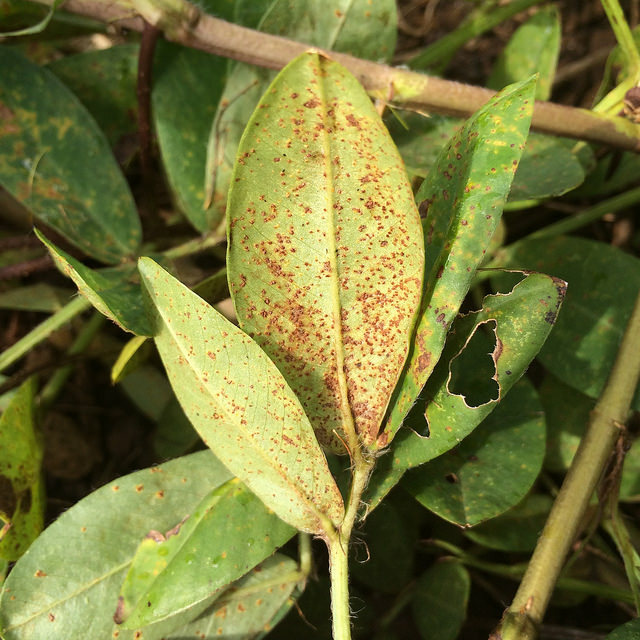
Symptoms of rust on peanut leaves
Symptoms
Characteristic orange pustules on undersides of leaves which become covered in masses of red-brown spores; pustules may form on pods.
Cause
Fungus
Comments
Management
Allow field to fallow for at least one month between successive peanut plantings; remove any volunteer peanut plants during fallowing to reduce inoculum; sprays of appropriate fungicides such as Bordeaux mixture can effectively control the disease; such fungicides are often also effective at controlling leaf spot.
Sclerotinia blight
Sclerotinia minor

Severe Sclerotinia blight on peanut

Sclerotia of Sclerotinia minor inside peanut pod
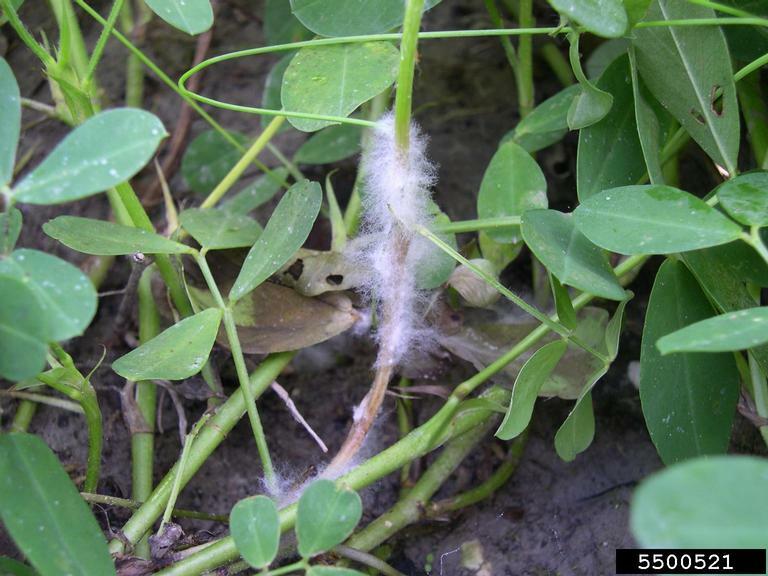
Early infection of Sclerotinia minor on peanut

Stem shredding by Sclerotinia minor on peanut

Hard black sclerotia on infected peanut stems

Sclerotia, stem bleaching and shredding by Sclerotinia minor on peanut
Symptoms
Tips of infected branches wilt or flag rapidly; early signs of infection include the presence of small water-soaked lesions at the base of the stems which turn yellow or bleached; leaves on infected branches turn chlorotic and then wither; fluffy white fungal growth may appear on infected tissues during periods of high humidity.
Cause
Fungus
Comments
Management
Plant seeds which are coated with protectants; avoid injuring plants with tools and/or machinery; application of appropriate fungicides can reduce crop losses when disease is present; avoid excessive irrigation during cool weather.
Southern stem rot
Sclerotium rolfsii

Below-ground symptoms of southern stem rot.

Dense white mycelial growth and brown sclerotia of Sclerotium rolfsii, causing southern stem rot of peanut

White fungal mat developing on the stem close to the soil line
Symptoms
Lateral branches or main stem yellowing and wilting; white fungal mat developing on the stem close to the soil line; white to brown spore containing structures developing from the fungal mats.
Cause
Fungus
Comments
Management
Plow crop debris deeply into soil after harvest of crop; crop rotation of 3-4 years are very effective at reducing soil inoculum in the case of severe infestations; applications of appropriate fungicides can help suppress stem rot but care should be taken with selection as some pesticides (e.g. benomyl) are known to increase the severity of the the disease.
Verticillium wilt
Verticillium spp.
Symptoms
Chlorosis of leaf margins; curling leaves; loss of leaf turgor; plants wilt and become stunted as the disease progresses; plants wilt rapidly during periods of water stress; vascular system becomes dicolored.
Cause
Fungi
Comments
Management
Irrigate plants frequently to reduce wilting of infected plants and allow them to reach maturity; eliminate weeds int he plantation which may allow inoculum to build up in the soil; remove and destroy infected crop residue after harvest to reduce inoculum in the field.
Web blotch (Phoma leaf spot)
Phoma arachidicola

Web blotch infected leaves
Symptoms
Circular, brown-black lesions on the upper surfaces of the leave; web or net-like brown lesions on leaves may form on leaves during periods of high humidity; as sisease progresses, lesions darken and develop a rough texture; lesions may cover entire leaf surface.
Cause
Fungus
Comments
Management
Remove and destroy infested crop debris to prevent build up of inoculum in soil; rotate crops away from peanut; foliar fungicide applications are largely ineffective if conditions are favorable for the disease.
Category : Viral
Stunt
Peanut stunt virus (PSV)
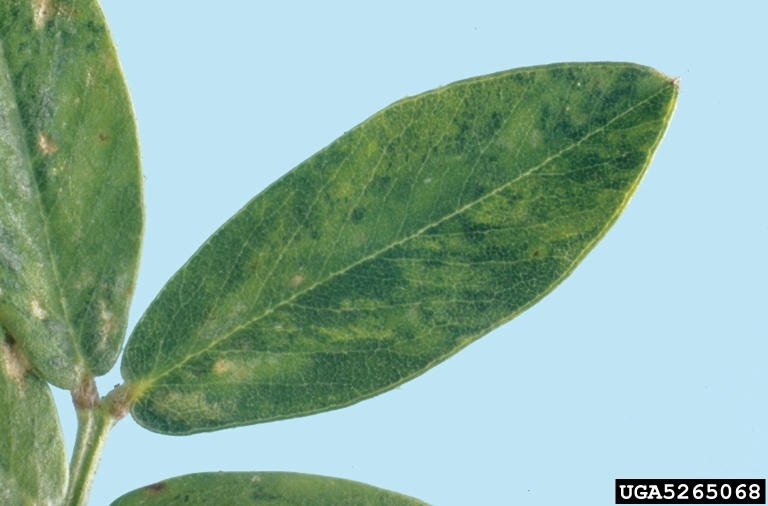
Peanut stunt virus infected leaf

Symptoms of peanut stunt virus on peanut leaves

Symptoms on leaves

Peanut stunt virus infected plants
Symptoms
Leaves curled and pale yellow to green; leaf petioles shortened; plants growth severely stunted; plants may produce very few pods if they have been infected early in the growing season.
Cause
Virus
Comments
Management
Avoid planting peanut in close proximity to legumes such as clover; remove any infected plants from plantation to reduce inoculum.
Tomato spotted wilt virus & Peanut bud necrosis
Tomato spotted wilt virus (TSWV)
Peanut bud necrosis virus (PBNV)
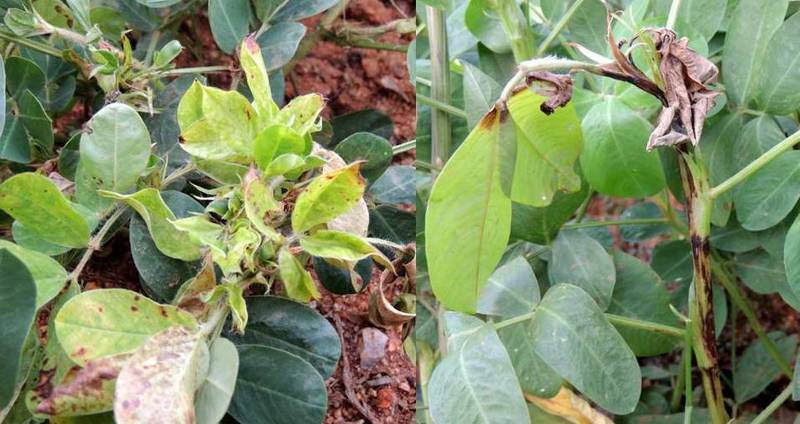
Groundnut bud necrosis disease symptoms:mild chlorotic mottle or specks on young, quadrifoliate leaves, which develop into chlorotic and necrotic rings and streaks (left). Necrosis of the terminal bud (right)
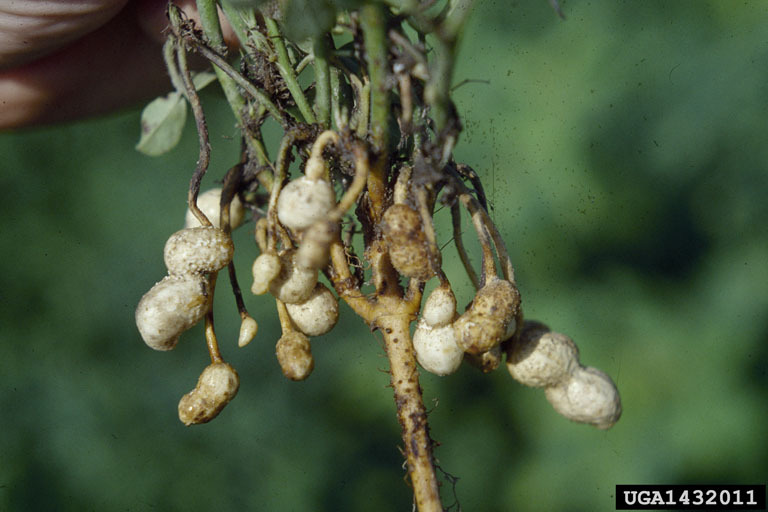
Stunted plant with small, darkened pods due to tomato spotted wilt virus

Tomato spotted wilt virus symptoms

Twisted terminal with mottled leaflets ue to tomato spotted wilt virus
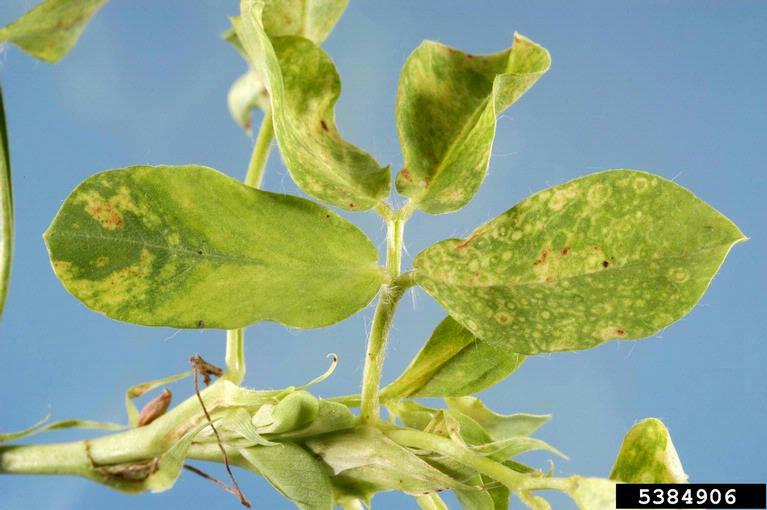
Symptoms of tomato spotted wilt virus
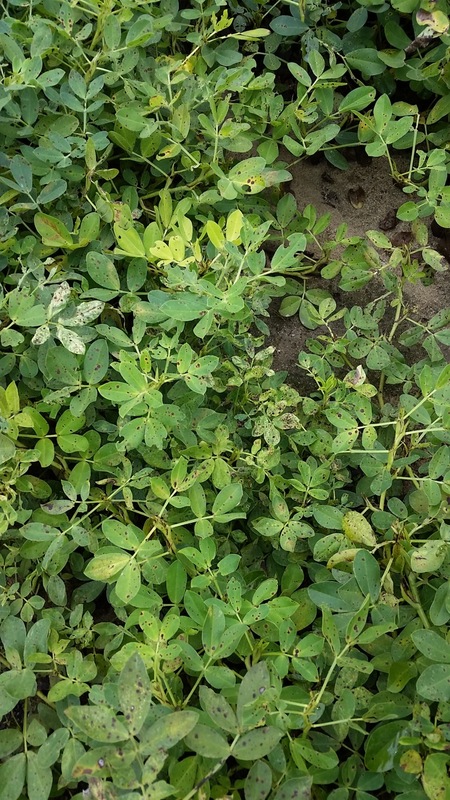
Tomato spotted wilt virus infected plants
Symptoms
Chlorotic spots or mottled patterns on leaves; drooping leaflets during hot weather; necrosis of terminal buds; stunted growth; new leaflets are reduced in size and may be puckered with mosaic mottling.
Cause
Virus
Comments
Management
Use high quality seed and use adequate plant spacings to avoid overcrowding; provide plants with adequate irrigation and fertilization to encourage the fast establishment of seedlings and growth of a close canopy which is unattractive to thrips vectors; intercropping peanut with sorghum or millet can reduce disease incidence.


























































